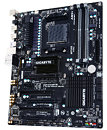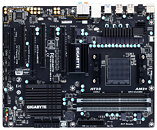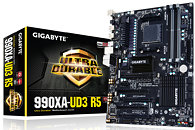Monday, March 23rd 2015

GIGABYTE Intros 990XA-UD3 R5 Socket AM3+ Motherboard
GIGABYTE introduced its latest socket AM3+ motherboard, and its first in a long while, the 990XA-UD3 R5. Built in the standard ATX form-factor, the board draws power from a combination of 24-pin ATX and 8-pin EPS connectors, and conditions it using a 10-phase CPU VRM. The board, however, does not support FX-9000 series chips. Based on AMD 990X chipset, featuring AMD SB950 southbridge, expansion slots of the board include two PCI-Express 2.0 x16 (x8/x8 when both are populated), supporting NVIDIA SLI and AMD CrossFireX, a third PCIe 2.0 x16 slot (electrical x4, wired to the southbridge), and two each of PCIe 2.0 x1 and legacy PCI slots.
Storage connectivity on the 990XA-UD3 R5 include six SATA 6 Gb/s ports. The board's onboard audio solution features a Realtek ALC1150 CODEC, offering 115 dBA SNR, audio-grade electrolytic capacitors on the audio circuit, a TI-made headphones amplifier with support for headphones impedance as high as 600Ω, and PCB ground-layer isolation. Also on offer are a gigabit Ethernet connection, driven by a Realtek-made controller, four USB 3.0 ports (two on the rear panel, two by headers), and PS/2 mouse/keyboard combo port. The board is driven by AMI UEFI BIOS, and supports Windows 8 SecureBoot and FastBoot. Expect this board to be priced around US $130.
Storage connectivity on the 990XA-UD3 R5 include six SATA 6 Gb/s ports. The board's onboard audio solution features a Realtek ALC1150 CODEC, offering 115 dBA SNR, audio-grade electrolytic capacitors on the audio circuit, a TI-made headphones amplifier with support for headphones impedance as high as 600Ω, and PCB ground-layer isolation. Also on offer are a gigabit Ethernet connection, driven by a Realtek-made controller, four USB 3.0 ports (two on the rear panel, two by headers), and PS/2 mouse/keyboard combo port. The board is driven by AMI UEFI BIOS, and supports Windows 8 SecureBoot and FastBoot. Expect this board to be priced around US $130.



55 Comments on GIGABYTE Intros 990XA-UD3 R5 Socket AM3+ Motherboard
There has been a couple of new boards come out with the 970 and 990 chipset.
This way they keep costs down and can sell it mainstream for general purpose.
The 12+2 phase Asrock mobos have proven to be excellent for the FX-9000 series as have some Asus models. Only use an AM3+ mobo properly rated for the FX-9000 CPUs to prevent VRM failure and many expensive headaches.
Mobo makers are not selling as many Intel mobos as they'd like in a down market so additional revenues from AMD mobos contribute to the revenue stream.
So yeah, not seeing any advantages for AMD.
sinhardware.com/index.php/vrm-list
With DX11 you have many occasions where a dual core Pentium outperforms an eight core(four core if you prefer) FX chip in many games thanks to Haswell's higher IPC. With DX12 that will probably change and the FX chips will be faster at more games compared to a Pentium or even a i3. I don't know if we will see cases where an 8core FX will be even better performing compared to a i5 in a DX12 game.
For the record AMD builds it's CPUs on dual core modules that are added in quantities to produce a quad, hex or octa CPU. The AMD dual-core CPU is exactly that TWO CPU cores in one module. The fact that it uses one instruction fetch segment, etc. to feed two cores does not make it anything less than a dual core CPU. While floating point performance can be reduced by using this technique, integer performance is not compromised. The fact that two cores actually process two data bits concurrently ends the technical ignorance that AMD CPUs are not truly dual, quad, hex or octa cores, because they are and it's obvious they are when they can be observed processing two bits concurrently via dual cores.
As far as value vs. performance, AMD has always been the leader and is likely to stay that way. Most PC consumers including enthusiasts do not buy the highest priced CPU available, they buy what they believe to be a good value. Each person can decide for themselves what serves their needs best and at the best price.
He said that eventually at some point a potential APU would be faster than an FX processor + a discrete graphics card.
Do you realise that might happen only if there is no more progress in the discrete CPUs & GPUs?!